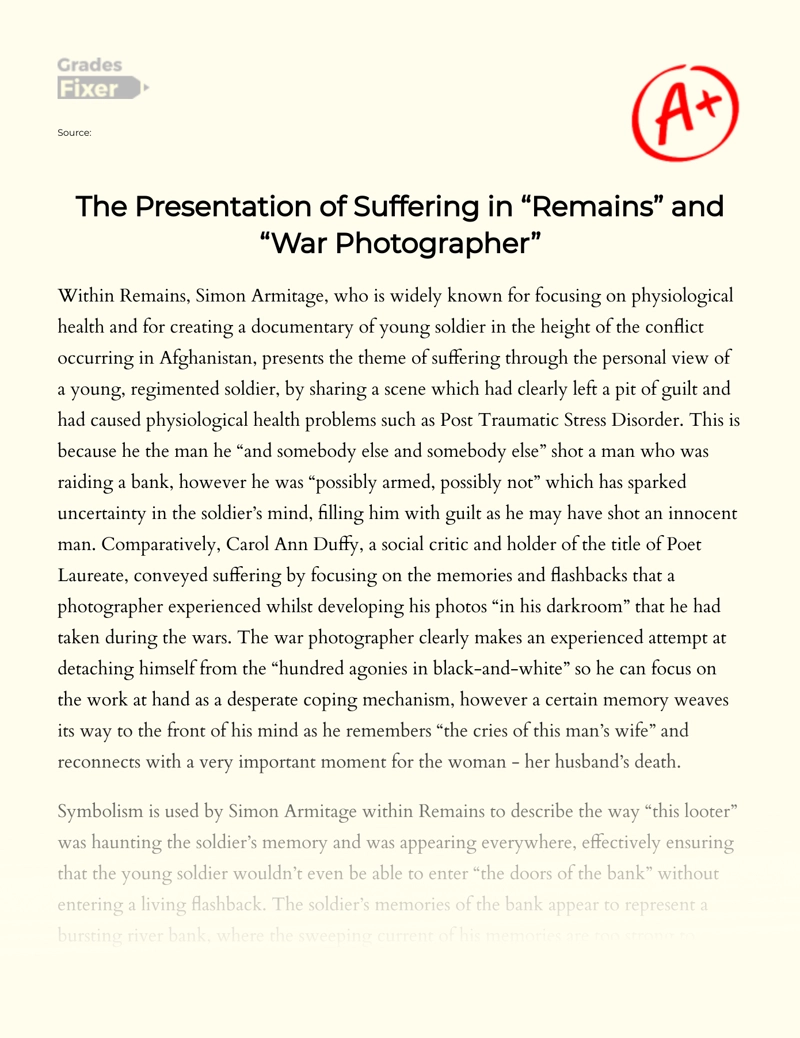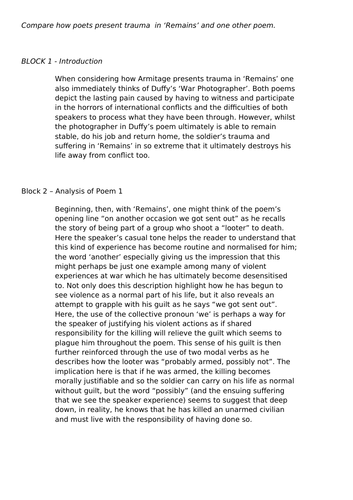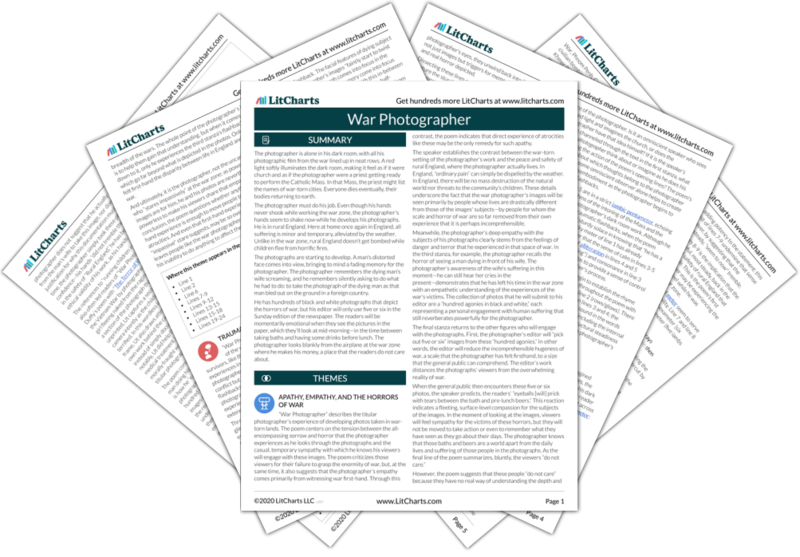War Photographer / Remains Essay
(grade 5-6).
Both ‘War Photographer’ and ‘Remains’ explore memories. In the second stanza of ‘War Photographer’, Duffy creates a vivid image of one of the photographer’s memories by writing ‘running children in a nightmare heat’. Duffy’s words create graphic, powerful imagery of innocent children caught up in the middle of a warzone, running in agony and terror away from a chemical weapon. Duffy suggests through these words that the photographer's mind is always filled with powerful and upsetting memories of the terrible things he witnessed while taking photos in warzones. Armitage makes clear the soldier cannot forget the memory of shooting the looter by writing ‘probably armed, possibly not’. Armitage’s repetition of these words in the poem emphasise that this particular memory, of whether or not the looter is armed, is very important. It is important because the soldier is wondering whether or not he needed to kill the looter. If the looter was not armed, the soldier killed an innocent person, who posed no threat to him. Armitage’s use of the word ‘possibly’ indicates that the soldier cannot be sure that the looter was armed, and runs this memory over and over in his mind. Armitage’s repetition of these words also emphasise the power of this memory, as it keeps flooding back into the soldier’s mind, even when he is home on leave. It is clear from both poems that being in or near war can deeply affect people, leaving them with lasting trauma.
Both ‘War Photographer’ and ‘Remains’ explore guilt. In the third stanza of War Photographer, Duffy makes the photographer’s guilt clear by writing that he sees a ‘half-formed ghost’ when he develops one of the photographs. Duffy’s imagery in the words ‘half-formed’ helps the reader to imagine the photograph slowly developing in front of his eyes. Her use of the word ‘ghost’ implies that the photographer is being haunted by the memory of this man and the cries of the man’s wife when she realised her husband was dead. Duffy suggests he feels guilty because he was not able to do more to help this man or his wife; all he could do was stand by and take a photograph. Similarly, in the closing lines of ‘Remains’, Armitage makes the soldier’s guilt clear by writing ‘his bloody life in my bloody hands’. Armitage uses the blood as a symbol of the guilt that the soldier feels; the soldier feels he has blood on his hands because he killed a person who could have been innocent. Armitage could have chosen to end the poem with this line because he wanted to demonstrate that the soldier cannot remove the image of the looter’s blood from his mind, and that the guilt he feels for killing the looter will stay with him forever.
Both poems explore struggle . In the final stanza of ‘War Photographer’, Duffy conveys the struggle of the photographer, who feels angry that his readers are not more moved by his pictures by writing ‘reader’s eyeballs prick with tears between the bath and pre lunch beers’. Duffy’s use of the word ‘prick’ to describe the readers’ emotions indicates that they barely cry when they see the photographs. Duffy’s suggestion is that, when we are so far removed from war, we cannot fully understand the pain that people go through. Duffy’s use of the words ‘bath’ and ‘beers’ remind the reader that in England we have many luxuries that people in warzones don’t have. This makes it very easy for us to forget the terrible lives that other people have, because we can go back to enjoying our own luxurious lifestyles. The struggle in Remains is different. In Remains, Armitage presents the soldier as deeply traumatised by what he experienced at war. Remains makes clear the soldier struggles to forget what he saw and did by writing ‘the drink and drugs won’t flush him out’.Armitage’s use of the word ‘flush’ implies that the emotions the soldier feels are like toxins within his body that he wants to get rid of. It is clear that the soldier has become reliant on addictive substances as a way of coping. Armitage conveys to his readers the terrible trauma that many soldiers experienced and tells the reader how difficult it was for them to return to normal life when they returned.

(Grade 8-9)
Both ‘War Photographer’ and ‘Remains’ explore the haunting power of memories. In the second stanza of ‘War Photographer’, Duffy creates a vivid image of one of the photographer’s memories by writing ‘running children in a nightmare heat’. Here, Duffy’s words create graphic, powerful imagery of innocent children caught up in the middle of a warzone, running in agony and terror away from a chemical weapon. This poetic image was inspired by a real-life photograph captured by a war photographer in Vietnam. Through this evocative imagery, Duffy suggests that the photographer's mind cannot shake the distressing memories of the terrible pain he witnessed while taking photos in warzones. Similarly, Armitage makes clear the soldier cannot forget the memory of shooting the looter through his use of the poem’s refrain: ‘probably armed, possibly not’. Armitage’s repetition of these words emphasise that this particular ambiguous memory, of whether or not the looter is armed, is haunting him. If the looter was not armed, the soldier would not have needed to kill him. Therefore, he is plagued by a feeling of potential guilt; ihe could have killed an innocent person, who posed no threat to him. Armitage’s repetition of these words throughout the poem also emphasise the power of this memory, as it keeps flooding back into the soldier’s mind, even when he is home on leave. It is an unwelcome and persistent reminder that is contributing to his post-traumatic symptoms. It is clear from both poems that being involved in or an observer of war can deeply affect people, leaving them with a lasting mental struggle.
Both ‘War Photographer’ and ‘Remains’ explore the intensity of guilt. In the third stanza of War Photographer, Duffy makes the photographer’s guilt evident by writing that he sees a ‘half-formed ghost’ when he develops one of the photographs. Duffy’s powerful metaphor helps the reader to vividly imagine the photograph slowly developing in a chemical solution in front of his eyes, while the word ‘ghost’ implies that the photographer is being psychologically haunted by the memory of this man and the terrible cries of the man’s wife. Perhaps Duffy suggests that the photographer feels guilty because he was not able to do more to help this man or his wife; all he could do was carry out his role by capturing the moment with a photograph for the media. TSimilarly, in the closing lines of ‘Remains’, Armitage makes the soldier’s guilt clear by writing ‘his bloody life in my bloody hands’. Armitage uses the blood as a symbol of the guilt that the soldier feels; the soldier feels he has blood on his hands because he killed a person who could have been innocent. Armitage could have chosen to end the poem with this line because he wanted to demonstrate that the soldier cannot remove the image of the looter’s blood from his mind, and that the guilt he feels for killing the looter will stay with him, or metaphorically stain him, forever.
Both poems explore an inner conflict or struggle . In the final stanza of ‘War Photographer’, Duffy conveys the struggle of the photographer, who feels infuriated that his readers are not more emotionally moved by his pictures by writing ‘reader’s eyeballs prick with tears between the bath and pre lunch beers’. Duffy’s use of the word ‘prick’ to describe the readers’ emotions indicates that they barely cry when they see the photographs, or that their emotion is transient because they cannot empathise with the people in the photographs as they are so far removed from conflict zones. Duffy’s use of the words ‘bath’ and ‘beers’ remind the reader that in England we have many everyday luxuries that people in warzones don’t have. This makes it easy and almost inevitable for us to forget the terrible lives that other people have, because we are so engrossed in our own luxurious lifestyles. While there is an emotional struggle for the soldier in Remains, the nature of the strife is different. In Remains, Armitage presents the soldier as deeply traumatised by what he experienced at war. Remains makes clear the soldier struggles to forget what he saw and how he behaved by writing ‘the drink and drugs won’t flush him out’.Here, Armitage’s use of the word ‘flush’ implies that the emotions the soldier feels are like toxins within his body that he wants to eject. It is clear that the soldier has become reliant on addictive substances as a way of coping with the devastating effects of war and its violent agony. Armitage conveys to his readers the terrible trauma that many soldiers experience, and exposes to the reader how difficult it is for soldiers to adapt to normal life when they return from war.
Both Duffy and Armitage use structure to reflect an attempt to control difficult emotions . In ‘War Photographer,’ Duffy deliberately uses a tight stanza structure with a clear rhyme scheme to mirror the order the photographer is trying to restore in his own mind. He is described as putting his photographs into “ordered rows,” just as Duffy carefully brings order to the poem. Perhaps she is suggesting that this sort of organisation is the only way he can eliminate the chaos and distress he struggles with. In Armitage’s poem, the soldier is less successful in containing his emotional outpourings. While the poem begins in an ordered way with regular stanza structures, it descends into irregular and erratic stanzas to perhaps symbolise his inability to control the traumatic memories which continue to flood his mind.
Home — Essay Samples — Literature — Carol Ann Duffy — The Presentation of Suffering in “Remains” and “War Photographer”
The Presentation of Suffering in "Remains" and "War Photographer"
- Categories: Carol Ann Duffy Poetry
About this sample

Words: 1735 |
Published: Jul 17, 2018
Words: 1735 | Pages: 4 | 9 min read

Cite this Essay
Let us write you an essay from scratch
- 450+ experts on 30 subjects ready to help
- Custom essay delivered in as few as 3 hours
Get high-quality help

Dr Jacklynne
Verified writer
- Expert in: Literature

+ 120 experts online
By clicking “Check Writers’ Offers”, you agree to our terms of service and privacy policy . We’ll occasionally send you promo and account related email
No need to pay just yet!
Related Essays
6 pages / 2692 words
3.5 pages / 1676 words
3 pages / 1406 words
6.5 pages / 3030 words
Remember! This is just a sample.
You can get your custom paper by one of our expert writers.
121 writers online

Still can’t find what you need?
Browse our vast selection of original essay samples, each expertly formatted and styled
In the poem ‘The Map Woman’, Carol Ann Duffy uses the extended metaphor of a map being printed on a woman’s body to explore ideas surrounding hometowns, childhood and nostalgia. This is immediately introduced in the first line [...]
Carol Ann Duffy wrote 'The World's Wife' in order to scrutinize the representation of both men and women, inspired by her strong feminist views -- reconstructing, for example, many of the 'voiceless women' from throughout [...]
Carol Ann Duffy’s poem entitled ‘Shooting Stars’ originally published in her first anthology “The World’s Wife” in 1999 is an emotive recount of the treatment of Jewish prisoners of the Holocaust during WWII. Whilst Duffy was [...]
The poem "Havisham" by Carol Ann Duffy is a captivating literary work that offers a unique perspective on a well-known character from Charles Dickens' "Great Expectations." In this essay, we will embark on a comprehensive [...]
Both ‘Before you were mine’ by Carol Anne Duffy and ‘Follower’ by Seamus Heaney present the theme of admiration through their poems. As they both capture the parent-child relationship through the child’s perspective showcasing [...]
The fear of a dystopian future that is explored in both Fritz Lang’s film Metropolis and George Orwell’s novel Nineteen Eighty Four is reflective of the values of the societies at the time and the context of the authors. As [...]
Related Topics
By clicking “Send”, you agree to our Terms of service and Privacy statement . We will occasionally send you account related emails.
Where do you want us to send this sample?
By clicking “Continue”, you agree to our terms of service and privacy policy.
Be careful. This essay is not unique
This essay was donated by a student and is likely to have been used and submitted before
Download this Sample
Free samples may contain mistakes and not unique parts
Sorry, we could not paraphrase this essay. Our professional writers can rewrite it and get you a unique paper.
Please check your inbox.
We can write you a custom essay that will follow your exact instructions and meet the deadlines. Let's fix your grades together!
Get Your Personalized Essay in 3 Hours or Less!
We use cookies to personalyze your web-site experience. By continuing we’ll assume you board with our cookie policy .
- Instructions Followed To The Letter
- Deadlines Met At Every Stage
- Unique And Plagiarism Free
- International
- Schools directory
- Resources Jobs Schools directory News Search

Model Essay - Remains and War Photographer
Subject: English
Age range: 14-16
Resource type: Assessment and revision
Last updated
20 May 2023
- Share through email
- Share through twitter
- Share through linkedin
- Share through facebook
- Share through pinterest

A Mini Model Essay (with the idea that students are taught and given examples on how to approach the task and they add to it), comparing Simon Armitage’s ‘Remains’ and Carol Ann Duffy’s ‘War Photographer’ from the Power and Conflict Poetry Cluster for the AQA Exam Board.
It is also broken into sections (Intro, Poem 1, Poem 2, Conclusion) to make clear to students how to organise each section of the essay.
Tes paid licence How can I reuse this?
Your rating is required to reflect your happiness.
It's good to leave some feedback.
Something went wrong, please try again later.
This resource hasn't been reviewed yet
To ensure quality for our reviews, only customers who have purchased this resource can review it
Report this resource to let us know if it violates our terms and conditions. Our customer service team will review your report and will be in touch.
Not quite what you were looking for? Search by keyword to find the right resource:

War Photographer Summary & Analysis by Carol Ann Duffy
- Line-by-Line Explanation & Analysis
- Poetic Devices
- Vocabulary & References
- Form, Meter, & Rhyme Scheme
- Line-by-Line Explanations

"War Photographer" is a poem by Scottish writer Carol Ann Duffy, the United Kingdom's poet laureate from 2009 to 2019. Originally published in 1985, "War Photographer" depicts the experiences of a photographer who returns home to England to develop the hundreds of photos he has taken in an unspecified war zone. The photographer wrestles with the trauma of what he has seen and his bitterness that the people who view his images are unable to empathize fully with the victims of catastrophic violence abroad. The poem references a number of major historical air strikes and clearly draws imagery from Nick Ut's famous Vietnam War photograph of children fleeing the devastation of a napalm bomb.
- Read the full text of “War Photographer”

The Full Text of “War Photographer”
“war photographer” summary, “war photographer” themes.

Apathy, Empathy, and the Horrors of War
Lines 13-15, lines 15-18.
- Lines 19-24

Trauma and Memory
Lines 11-12.
- Lines 13-18

The Ethics of Documenting War
Line-by-line explanation & analysis of “war photographer”.
In his dark ... ... in ordered rows.

The only light ... ... intone a Mass.
Belfast. Beirut. Phnom ... flesh is grass.
He has a ... ... seem to now.
Rural England. Home ... ... weather can dispel,
to fields which ... ... a nightmare heat.
Something is happening. ... ... a half-formed ghost.
He remembers the ... ... into foreign dust.

Lines 19-21
A hundred agonies ... ... for Sunday’s supplement.
Lines 21-22
The reader’s eyeballs ... ... and pre-lunch beers.
Lines 23-24
From the aeroplane ... ... do not care.
“War Photographer” Symbols

Photographs
- Line 2: “with spools of suffering set out in ordered rows”
- Line 7: “Solutions slop in trays”
- Lines 13-15: “A stranger’s features / faintly start to twist before his eyes, / a half-formed ghost”
- Line 19: “A hundred agonies in black and white”
“War Photographer” Poetic Devices & Figurative Language
Alliteration.
- Line 2: “s,” “s,” “s”
- Line 4: “th,” “th”
- Line 5: “pr,” “pr”
- Line 6: “B,” “B,” “P,” “P”
- Line 7: “H,” “h,” “S,” “s”
- Line 8: “h,” “h,” “th”
- Line 9: “th”
- Line 13: “S,” “s,” “t,” “f”
- Line 14: “f,” “s,” “t,” “t,” “t”
- Line 16: “h,” “h”
- Line 17: “w,” “w,” “w”
- Line 20: “s”
- Line 21: “S,” “s”
- Line 22: “b,” “b,” “b”
- Line 6: “Belfast. Beirut. Phnom Penh. All flesh is grass.”
- Lines 11-12: “to fields which don’t explode beneath the feet / of running children in a nightmare heat.”
- Line 6: “All flesh is grass.”
- Line 1: “I,” “i”
- Line 2: “o”
- Line 3: “o,” “o”
- Line 4: “ou,” “e,” “u,” “e”
- Line 5: “ie,” “a”
- Line 6: “e,” “a,” “e,” “e,” “a”
- Line 8: “i,” “i,” “i,” “e,” “e”
- Line 10: “i,” “i,” “ea,” “e”
- Line 11: “ie,” “o,” “o,” “ea,” “ee”
- Line 13: “i,” “i,” “i,” “a,” “e,” “u”
- Line 14: “ai”
- Line 15: “ie”
- Line 16: “i”
- Line 17: “o,” “o,” “a,” “o,” “o,” “u”
- Line 18: “oo,” “u”
- Line 19: “a,” “a,” “a”
- Line 20: “i,” “i,” “i,” “i,” “i,” “i”
- Line 21: “u,” “u,” “i”
- Line 22: “i,” “ea,” “ee,” “e,” “ee”
- Line 23: “a,” “a,” “a,” “e”
- Line 24: “i,” “i”
- Line 6: “Belfast. Beirut. Phnom Penh. All”
- Line 7: “do. Solutions”
- Line 8: “hands, which”
- Line 9: “now. Rural England. Home”
- Line 13: “happening. A”
- Line 15: “ghost. He”
- Line 16: “wife, how”
- Line 21: “supplement. The”
- Line 1: “r,” “r,” “n,” “ll,” “l,” “n”
- Line 2: “s,” “l,” “s,” “s,” “t,” “t,” “r,” “d,” “r,” “d,” “r”
- Line 3: “l,” “l,” “l,” “l”
- Line 5: “pr,” “pr,” “p,” “r,” “t,” “t,” “ss”
- Line 6: “B,” “s,” “t,” “B,” “t,” “P,” “n,” “P,” “n,” “ll,” “l”
- Line 7: “H,” “h,” “S,” “l,” “sl”
- Line 8: “h,” “s,” “h,” “s,” “t,” “t,” “th”
- Line 9: “th,” “R,” “r,” “g,” “g,” “n”
- Line 10: “n,” “p,” “n,” “w,” “p,” “l,” “w,” “d,” “p,” “l”
- Line 11: “l,” “d,” “d,” “pl,” “d,” “th,” “th”
- Line 12: “n,” “n”
- Line 13: “S,” “str,” “r,” “s,” “t,” “r,” “s”
- Line 14: “f,” “t,” “st,” “t,” “t,” “t,” “st”
- Line 15: “f,” “f”
- Line 16: “w,” “h,” “w,” “h”
- Line 17: “w,” “w,” “d,” “d,” “w,” “eo”
- Line 18: “d,” “st,” “d,” “d,” “st”
- Line 21: “S,” “s,” “s,” “s,” “r”
- Line 22: “t,” “rs,” “b,” “tw,” “th,” “b,” “th,” “r,” “b,” “rs”
- Line 23: “s,” “r,” “ss,” “r”
- Line 24: “r,” “s,” “s”
End-Stopped Line
- Line 2: “rows.”
- Line 3: “glows,”
- Line 5: “Mass.”
- Line 6: “grass.”
- Line 10: “dispel,”
- Line 12: “heat.”
- Line 14: “eyes,”
- Line 18: “dust.”
- Line 22: “beers.”
- Line 24: “care.”
- Lines 1-2: “alone / with”
- Lines 4-5: “he / a”
- Lines 7-8: “trays / beneath”
- Lines 8-9: “then / though”
- Lines 9-10: “again / to”
- Lines 11-12: “feet / of”
- Lines 13-14: “features / faintly”
- Lines 15-16: “cries / of”
- Lines 16-17: “approval / without”
- Lines 17-18: “must / and”
- Lines 19-20: “white / from”
- Lines 20-21: “six / for”
- Lines 21-22: “prick / with”
- Lines 23-24: “where / he”
- Line 2: “spools of suffering”
- Line 6: “All flesh is grass”
Parallelism
- Lines 10-11: “to ordinary pain which simple weather can dispel, / to fields which don’t explode beneath the feet”
- Lines 16-18: “how he sought approval / without words to do what someone must / and how the blood stained into foreign dust.”
- Lines 4-5: “as though this were a church and he / a priest preparing to intone a Mass.”
“War Photographer” Vocabulary
Select any word below to get its definition in the context of the poem. The words are listed in the order in which they appear in the poem.
- "All flesh is grass"
- Sunday's supplement
- Impassively
- (Location in poem: Line 1: “dark room”)
Form, Meter, & Rhyme Scheme of “War Photographer”
Rhyme scheme, “war photographer” speaker, “war photographer” setting, literary and historical context of “war photographer”, more “war photographer” resources, external resources.
"War Photographer" Read Aloud — Listen to the poem read aloud.
Trailer for the Documentary "War Photographer" — Watch the trailer for the 2011 documentary War Photographer, which explores the responsibilities of photographers in war zones, focusing on photographer James Nachtwey.
"The Terror of War" — Explore Nick Ut's image from the Vietnam War, "The Terror of War." This famous photograph may have inspired "War Photographer." Note the second photographer at the right of the image examining his camera as children run by him, burnt and naked.
Carol Ann Duffy Biography — Learn more about Carol Ann Duffy, Britain's first female Poet Laureate, on Poets.org.
Interview with War Photographer Nick Ut — Watch this NBC interview with Vietnam War photographer Nick Ut about taking his famous photo depicting the naked "Napalm Girl" and the responsibility of photographers in war zones. Ut's comments intersect potently with the themes explored in "War Photographer."
LitCharts on Other Poems by Carol Ann Duffy
A Child's Sleep
Anne Hathaway
Before You Were Mine
Death of a Teacher
Education For Leisure
Elvis's Twin Sister
Head of English
In Mrs Tilscher’s Class
In Your Mind
Little Red Cap
Mrs Lazarus
Mrs Sisyphus
Pilate's Wife
Pygmalion's Bride
Queen Herod
Recognition
Standing Female Nude
The Darling Letters
The Dolphins
The Good Teachers
Warming Her Pearls
We Remember Your Childhood Well
Everything you need for every book you read.

Join Now to View Premium Content
GradeSaver provides access to 2356 study guide PDFs and quizzes, 11005 literature essays, 2763 sample college application essays, 926 lesson plans, and ad-free surfing in this premium content, “Members Only” section of the site! Membership includes a 10% discount on all editing orders.
Simon Armitage: Poems
The presentation of suffering in "remains" and "war photographer" isabel grace alford 9th grade.
Within Remains, Simon Armitage, who is widely known for focusing on physiological health and for creating a documentary of young soldier in the height of the conflict occurring in Afghanistan, presents the theme of suffering through the personal view of a young, regimented soldier, by sharing a scene which had clearly left a pit of guilt and had caused physiological health problems such as Post Traumatic Stress Disorder. This is because he the man he “and somebody else and somebody else” shot a man who was raiding a bank, however he was “possibly armed, possibly not” which has sparked uncertainty in the soldier’s mind, filling him with guilt as he may have shot an innocent man. Comparatively, Carol Ann Duffy, a social critic and holder of the title of Poet Laureate, conveyed suffering by focusing on the memories and flashbacks that a photographer experienced whilst developing his photos “in his darkroom” that he had taken during the wars. The war photographer clearly makes an experienced attempt at detaching himself from the “hundred agonies in black-and-white” so he can focus on the work at hand as a desperate coping mechanism, however a certain memory weaves its way to the front of his mind as he remembers “the cries of this...
GradeSaver provides access to 2313 study guide PDFs and quizzes, 10989 literature essays, 2751 sample college application essays, 911 lesson plans, and ad-free surfing in this premium content, “Members Only” section of the site! Membership includes a 10% discount on all editing orders.
Already a member? Log in

IMAGES
VIDEO
COMMENTS
Both ‘War Photographer’ and ‘Remains’ explore guilt. In the third stanza of War Photographer, Duffy makes the photographer’s guilt clear by writing that he sees a ‘half-formed ghost’ when he develops one of the photographs. Duffy’s imagery in the words ‘half-formed’ helps the reader to imagine the photograph slowly ...
The impact of war is presented through graphic and visceral imagery in both poems. In ‘War Photographer’, there is a semantic field of violence, which conveys the feeling that although he is in “rural England”, he will always be haunted by the atrocities he witnessed: “pain”, “explode”, “ghosts” and “agonies”.
Both ‘Remains’ by Simon Armitage and ‘War Photographer’ by Carol Ann Duffy explore the emotional, physical and psychological impacts on the poems’ subjects, as a result of war. In ‘Remains’, Armitage immediately thrusts the reader into the soldier’s first-hand experience of war.
Within Remains, Simon Armitage, who is widely known for focusing on physiological health and for creating a documentary of young soldier in the height of the conflict occurring in Afghanistan, presents the theme of suffering through the personal view of a young, regimented soldier, by sharing a scene which had clearly left a pit of guilt and had caused physiological health problems such as ...
GCSE Grade 9 AQA Power and Conflict Poetry Essay – Comparing Simon Armitage’s ‘Remains’ with Carol Ann Duffy’s ‘War Photographer’.You can also access this co...
GCSE Grade 9 AQA Power and Conflict Poetry Essay – Comparing Carol Ann Duffy’s ‘War Photographer’ with Simon Armitage’s ‘Remains’You can also access this com...
docx, 16.29 KB. A Mini Model Essay (with the idea that students are taught and given examples on how to approach the task and they add to it), comparing Simon Armitage’s ‘Remains’ and Carol Ann Duffy’s ‘War Photographer’ from the Power and Conflict Poetry Cluster for the AQA Exam Board. It is also broken into sections (Intro, Poem 1 ...
The war photographer clearly makes an experienced attempt at detaching himself from the “hundred agonies in black-and-white” so he can focus on the work at hand as a desperate coping mechanism, however a certain memory weaves its way to the front of his mind as he remembers “the cries of this... Join Now to View Premium Content
Get LitCharts A +. "War Photographer" is a poem by Scottish writer Carol Ann Duffy, the United Kingdom's poet laureate from 2009 to 2019. Originally published in 1985, "War Photographer" depicts the experiences of a photographer who returns home to England to develop the hundreds of photos he has taken in an unspecified war zone.
Essays About Simon Armitage: Poems; A Critical Analysis of Simon Armitage's Out of the Blue, Section 7; The Presentation of Suffering in "Remains" and "War Photographer" How Armitage and Nichols Create Meaning Through the Language of 'The Manhunt' and 'A Praise Song for My Mother' Warping Conventions in Simon Armitage’s “Poem”